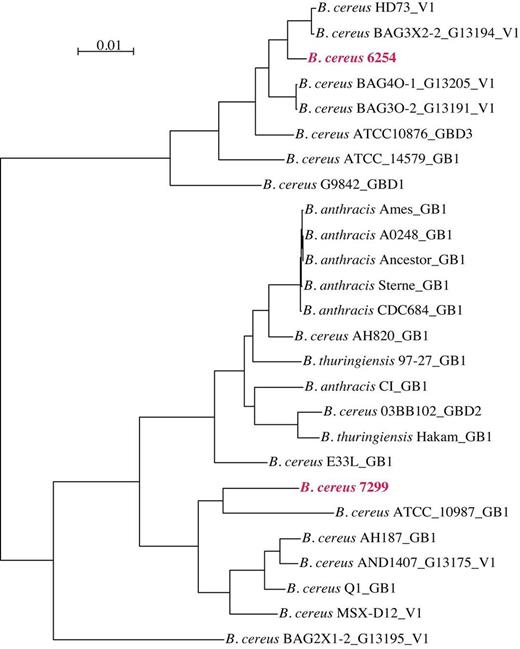Abstract
Background
Bacillus cereus has been associated with central nervous system (CNS) infections in immunocompromised patients.1 We report 5 cases of neuroinvasive B.cereus infections (4 fatal) in patients with acute myelogenous leukemia (AML) at Brigham and Women’s Hospital (BWH) in Boston from May 2013 to February 2014.
Methods
Clinical Investigation: Cases were defined as patients with positive blood or CNS cultures for B.cereus and/or positive PCR tests from CNS specimens and radiological evidence of acute CNS disease >48 hours after admission. Infection control practices were observed. A case-control analysis of medications and exposures was conducted; odds ratios and p-values were calculated via Fisher’s exact test.
Genomic Analysis: Genomic DNA was extracted from patient-derived and environmental B. cereus isolates. Sequencing libraries were prepared and paired-end whole genome sequencing (WGS) was performed. Sequencing reads were computationally assembled using several existing tools (SPAdes, AllPaths-LG, VELVET, and Newbler). Draft genome annotation was performed using RAST and Prodigal. All single copy core genes were aligned using MUSCLE and a phylogenetic tree was generated using FastTree and RAxML.
Results
Clinical Investigation: All 5 cases were AML patients who received chemotherapy. All had neutropenic fevers early in their course that resolved with empiric antibiotics. Fever recurred > 1 week into hospitalization (median onset 17 days, range 9-20) with headaches, neurological changes, and abnormal CNS imaging. Three had documented B. cereus bacteremia with bacilli identified on CNS pathological stains; two had positive CNS cultures. Four patients expired. Autopsies were notable for intestinal ulcers with Gram-positive bacilli in 2 patients.
No infection control breaches were observed. Of 43 environmental samples, 4 tested positive for B.cereus, including a kitchen cart where bananas were stored, the shelf of a blanket warmer, and an air sample near a construction site. On case-control analysis, no medications were associated with cases. The only significant food exposures were bananas (OR 9.3, p=0.04) and cranberry juice (OR 9.6, p=0.04).
Genomic Analysis:
WGS data was obtained for all B. cereus isolates from BWH (n=4) and swabs of environmental screening efforts from BWH (n=4). Two patient isolates (7299 and 6254) were taken forward for pilot analysis. A comparison of various computational assembly tools demonstrated that the SPAdes assembler exhibited superior performance. SPAdes was thus used for draft genome assembly for the remaining isolates. Phylogenetic analysis of isolates 7299 and 6254 revealed that the organisms were genetically distinct from one another (Fig. 1). Genomic analysis and multilocus sequence typing (performed by WGS and independently by PCR amplification/Sanger sequencing) confirmed that all strains were genetically distinct from one another, and suggested that the environmental strains were relatively divergent from the pathogenic strains studied.
Conclusions
Neuroinvasive B.cereus infection should be suspected in febrile AML patients with acute neurological symptoms, even those with negative blood cultures.
The clinical investigation suggests the outbreak may have been attributable to gastrointestinal inoculation, possibly secondary to bananas. Of note, the B. cereus strain cultured from the suspected banana source was not identical to the pathogenic strains. Multiple changes in practice were instituted as a consequence of this outbreak including enhanced environmental cleanings, temporary modification of empiric antibiotic recommendations for recurrent neutropenic fever (vancomycin, cefepime, and ciprofloxacin) and the placement of all AML patients on diets that excluded fresh fruits, vegetables, and rice. Six months have elapsed since the last case.
WGS demonstrated that the case series was not the result of a single, hyper-virulent B. cereus organism. Rather, the infections appear to have been attributable to distinct B. cereus strains that fall into two distinct genotypic clusters. Ongoing comparative microbial genomic and biological efforts are underway and have identified candidate bacterial and host factors that may induce heightened virulence in this patient population.
1. Inoue et al. Leukemia & lymphoma. 2010;51(5):860-9.
No relevant conflicts of interest to declare.
Author notes
Asterisk with author names denotes non-ASH members.


This feature is available to Subscribers Only
Sign In or Create an Account Close Modal